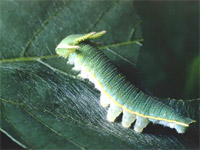|

Caterpillars have long segmented bodies with legs. They do not
breathe through their mouths, but through a series of small tubules
along the sides of their thorax and abdomen. These tubules are called
'spiracles', and inside the body they connect together into a network
of airtubes. Although they have poor eyesight and hearing, they
do have a series of six tiny eyelets or 'stemmata' on the lower
portion of their head, and rely on their antennae to help them locate
food.

Camoupillars: Many species of birds and animals consider caterpillars to be a
tasty protein snack, so the caterpillars have evolved several methods
of protecting and/or camouflaging themselves. These methods can
be either passive, aggressive, or both. Some caterpillars have large
'false eyes' towards the rear of their abdomen. This is an attempt
to convince predators that their back is actually their front, giving
them an opportunity to escape to the 'rear' when attacked.  Others
have a body coloration that closely resembles their food plant. Others
have a body coloration that closely resembles their food plant.
Fighters: More aggressive self-defense measures are taken by the spitfires
and hairy caterpillars. These caterpillars have spiny bristles or
long fine hairs that will irritate anything that brushes against
them, or spit acidic digestive juices at potential enemies. However,
some birds, like cuckoos, will swallow the hairiest of caterpillars.
Poisonpillars: Some caterpillars eat the leaves of plants that are toxic to other
animals. They are unaffected by the poison themselves, but it builds
up in their system, making them highly toxic to anything that eats
one of them. These toxic species, such as the Cinnabar moth (Tyria
jacobaeae) caterpillars, are brightly striped or coloured in red
and yellow - the 'danger' colours.
The aim of all these aggressive defense measures is to assure that
any predator that eats (or tries to eat) one of them will not be
in a hurry to repeat the experience.
Friendly communication: Some caterpillars obtain protection by associating themselves with
ants. The Lycaenid butterflies are particularly well known. Recent
findings have shown that they communicate with their ant protectors
by means of vibrations as well as chemical means.
 Big eaters: Caterpillars have rightfully been called eating machines. They
eat leaves voraciously, shed their skins generally four or five
times, and eventually pupate into an adult form. Caterpillars have
the fastest growth rate of any animal in the world. For instance,
a tobacco hornworm will increase its own weight ten thousand times
in less than twenty days. One of their adaptations that enables
them to eat this much is a mechanism in a specialized midgut which
transports ions at a very high rate to the lumen (midgut cavity),
to keep the potassium level higher in the midgut cavity than in
the blood. This mechanism is not found in any vertebrates. Big eaters: Caterpillars have rightfully been called eating machines. They
eat leaves voraciously, shed their skins generally four or five
times, and eventually pupate into an adult form. Caterpillars have
the fastest growth rate of any animal in the world. For instance,
a tobacco hornworm will increase its own weight ten thousand times
in less than twenty days. One of their adaptations that enables
them to eat this much is a mechanism in a specialized midgut which
transports ions at a very high rate to the lumen (midgut cavity),
to keep the potassium level higher in the midgut cavity than in
the blood. This mechanism is not found in any vertebrates.
All text is available under the terms
of the GNU Free Documentation License
|